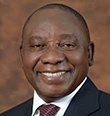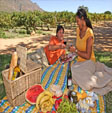Situated at the southern tip of Africa, South Africa has a landmass of 1 233 404 km² edged on three sides by a nearly 3000km coastline washed by the Indian Ocean and the Atlantic. It is bordered in the north by Namibia, Botswana, Zimbabwe and Mozambique, and also wraps itself around two independent countries, Lesotho and Swaziland.
Capitals:
South Africa has three capitals: Cape Town (Legislative), Pretoria (Administrative) and Bloemfontein (Judicial).

Political system:
A well-known fact about South Africa is that since 1994 South Africa has enjoyed a democratic government, with the apartheid policies of the past overthrown. In 1994, world icon, Nelson Mandela became South Africa’s first democratic president. (Nelson Mandela Foundation). South Africa’s constitution is regarded as an example to the world, and enshrines a wide scope of human rights protected by an independent judiciary. The country is currently headed by President Cyril Ramaphosa, pictured, of the African National Congress (ANC).
Economy:
A lesser-know n fact on South Africa is that it has achieved steady economic growth in gross domestic product (GDP) since the late 90s. The country, regarded as an emerging market, has a well developed financial sector and active stock exchange. Financial policies have focused on building solid macroeconomic structures. The country’s central bank is the Reserve Bank.
Tourism:
Since the demise of apartheid, international tourist arrivals have surged, making tourism one of the fastest growing sectors. The tourism industry is well-established with an exciting sector of emerging entrepreneurs. The country is strong on adventure, sport, nature and wildlife travel and is a pioneer and global leader in responsible tourism.

Population:
The South African population of more than 55 million people (as at 2016) is extremely diverse. Africans are in the majority, comprising approximately 80.7% of the population, followed by the Coloured population (8.8%), the White population (8.1%) and Indian/Asian population (2.5%).
Currency:
South Africa’s currency is the rand, which offers visitors great value for money. The rand comes in a range of coins (R1 = 100 cents) and note denominations of R10, R20, R50, R100 and R200.
Climate:
South Africa has a temperate climate and is known for its long sunny days, hence the title: ‘Sunny South Africa’. Most of the provinces have summer rainfall, except for the Western Cape (winter rainfall). Winter is from May to August; Spring from September to October; Summer from November to February and Autumn is from March to April.
Communications:
South Africa has an exceptionally well-developed communications infrastructure. A number of cell-phone providers provide national coverage and there are well-established landline phone networks. Internet and Wi-Fi are easily accessible in most urban areas.
Provinces:
There are nine provinces in South Africa, namely: Eastern Cape, Free State, Gauteng, KwaZulu-Natal, Limpopo, Mpumalanga, North West, Northern Cape and Western Cape.
National Symbols:
The South African flag is a symbol of patriotism and other significant national emblems include: National bird: blue crane; National animal: the springbok; National fish: galjoen; National flower: protea and National tree: the yellowwood.
Languages:
South Africa is a multi-lingual country with 11 official languages including: English, Afrikaans, isiNdebele, isiXhosa, isiZulu, Sepedi, Sesotho, Setswana, Siswati, Tshivenda and Xitsonga.
Religions:
Almost 80% of South Africa’s population is Christian. Other major religious groups include Hindus, Muslims, Jews and Buddhists. A minority don’t belong to any of the major religions. The Constitution guarantees freedom of worship.
Water:
Tap water is potable. However, ensure that you take bottled water with you when travelling to remote rural areas and the bush.
Animals and Plants:
South Africa has been declared one of the 18 megadiverse destinations in the world. As a pioneer and leader in responsible tourism, South Africa has numerous conservation projects to protect its natural heritage – travellers can support and take part in many of these projects. The country is home to the famous Big Five (rhino, elephant, lion, leopard and buffalo).
Electricity:
The South African electricity supply is 220/230 volts AC 50 HZ. With a few exceptions (in deep rural areas) electricity is available almost everywhere.
Airports:
The three major international airports in South Africa are: OR Tambo (Johannesburg), Cape Town and King Shaka (Durban) as well as 90 regional airports including the Kruger Mpumalanga International Airport (KMIA) in Nelspruit.

Travel by Road and Rail:
South Africa has an extensive road infrastructure including national highways and secondary roads. Speed limits are set at 120 kilometres on highways; 100 kilometres on secondary roads and 60 kilometres in urban areas.
Health and safety:
South Africa is well-known for its medical skill since Professor Christiaan Barnard performed the first successful heart transplant in 1967. There are many world-class private hospitals and medical centres around the country, especially in the urban centres. Most of South Africa is malaria-free, but always check with the game reserves you’re planning to visit and take precautions if necessary. Make sure you have the latest safety tips from the establishment where you will be staying and take common sense precautions as you would when travelling.
Curious for more information about South Africa? Visit the website of South African Tourism.
For an overview of the South African trade and investment environment, visit our Trade and Investment page.